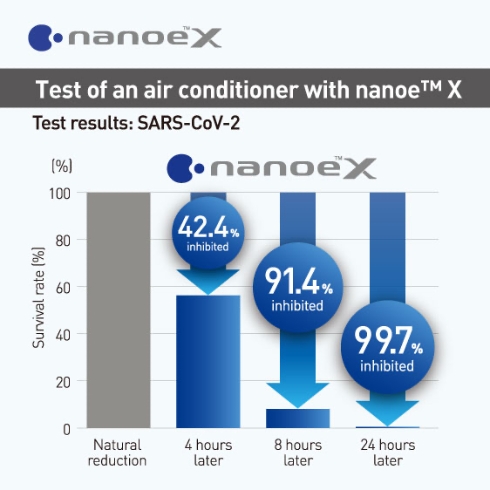
The Complete Air Management System
helps with antivirus protection.

When the number of people in the room increases,
the number of viruses increase.
The CO2 sensor activates the supply fan and viruses are expelled.

The CO2 concentration is detected by the Indoor Air Quality (IAQ) remote controller.
To prevent viral infections, ventilation is conducted in accordance with occupant tracking via CO2 sensing.

Appropriate ventilation volume is effective for virus removal.
Viruses are released with the sneezing and coughing of an infected person. The smaller the particle size of the droplet expelled, the longer it will float in the air and the farther it will travel. The spread of droplets can be controlled with an appropriate indoor airflow plan. In addition, the greater the ventilation volume and frequency, the lower the risk of infection because the concentration of airborne viruses is diluted and the human exposure dose is reduced.
Sources: Architectural Institute of Japan [AIJ]. (2020b). Activity HUB related to COVID-19.
Motoya Hayashi, U Yanagi, Kenichi Azuma, et al. Measures against COVID-19 concerning Summer Indoor Environment in Japan. Japan Architectural Review (2020).


With humidity fluctuating up and down, viruses are active.
Controlling humidity can inhibit the activity of viruses caused by high humidity.

Keeping humidity stable between 40-60%
To help prevent illness at home, it is important to maintain relative humidity in the 40-60% range. The system can constantly monitor humidity. Humidification can be achieved by taking in outdoor air. Dehumidification is achieved by removing indoor humidity with the dry mode of the air conditioner.

Optimal humidity range for minimizing adverse health effects
An air conditioner with a dehumidifying function can prevent various adverse effects by preventing a rise in humidity in the environment.
Source: Sterling, E.M., et al. ‘‘Criteria for human exposure to humidity in occupied buildings.’’
ASHRAE Transactions, 1985, vol. 91, Part 1.


Viruses adhere to doorknobs, light switches and other objects due to human contact. And airborne viruses can fill an enclosed room.
nanoe™ X technology inhibits adhered, also airborn viruses.

Air conditioner with nanoe™ X technology
nanoe™ X
Hydroxyl radicals contained in water, nanoe™ X particles do not readily bond with other substances.
Ordinary ions
Ordinary ions readily bond with oxygen and nitrogen in the air and thus are neutralised.

Confirmed to inhibit 91.4% of novel coronavirus in 8 hours
The global contract research organization Texcell has verified the inhibitory effect of nanoe™ X technology on the novel coronavirus (SARS-CoV-2). Thanks to the action of hydroxyl radicals contained in water, over 91.4% of novel coronavirus activity was inhibited within 8 hours in a 6.7 m3 test space.
(1) The virus infectious titer was measured and used to calculate the inhibition rate.
(2) This verification was designed to generate basic research data on the effects of nanoe™ X on the novel coronavirus in laboratory conditions. Actual effects will vary depending on the environment and usage of the product.



